Part 1: Getting Started With PostGIS: An almost Idiot's Guide
Printer Friendly
What Is PostGIS?
PostGIS is an open source, freely available, and
fairly OGC compliant spatial database extender for the PostgreSQL
Database Management System. In a nutshell it adds spatial functions
such as distance, area, union, intersection, and specialty geometry, geography, and raster data types to the
database. PostGIS is very similar in functionality to SQL Server Spatial support, ESRI ArcSDE,
Oracle Spatial, and DB2 spatial extender except it has more functionality and generally better performance than all of those (and it won't bankrupt you). The latest release version
now comes packaged with the PostgreSQL DBMS installs as an optional
add-on. As of this writing PostGIS 3.3.2 is the latest stable release and PostGIS 3.4.0 will be coming out within the next year. Features new in PostGIS 3.3 and new in Upcoming PostGIS 3.4. Notable features of PostGIS:
- Flat earth including 3D geometry support (part of postgis extension), advanced 3D in postgis_sfcgal extension
- Round-earth (geography type) spatial support (part of postgis extension)
- Advanced 3D analytics via SFCGAL Enhanced 3D geometry and other geometry processing functions.
- SQL/MM topology support: via postgis_topology extension
- Seamless raster/vector analysis support via the postgis_raster extension including an easy to use command line raster database loader that supports various types and can load whole folders of raster files with one commandline statement, and really jazzy image export functions to output both raster and geometries as PNG/TIFF and other raster formats.
- the graphical gui loader,which is packaged with the Windows Application Stack builder and some other desktop distros, includes batch file uploading as well as exporting.
You will find this installed in your PostgreSQL/bin folder and is called shp2pgsql-gui.exe.
- Geocoding for US data utilizing US Census Tiger Data using the postgis_tiger_geocoder extension
- Standardizing addresses using address_standardizer extension for parsing addresses into parts, useful for geocoding addresses.
The PostGIS Windows bundle also includes cool PostGIS related extensions that augment your spatial enjoyment. In the bundle you will also find:
- pgRouting for building routing applications.
- ogrfdw for querying remote spatial data sources. This includes curl support so you can query web services such as WFS services as well.
- pgpointcloud for storing LIDAR data in compress POINTPATCH and also performing various operations on it.
- h3-pg for using Uber h3 indexing scheme and converting h3 hexagons back and forth between postgis geometry/geography representations and h3index hashes
We will assume a windows environment for this
tutorial, but most of the tutorial will apply to other supported
platforms such as Linux, Unix, BSD, Mac etc. We will also be using
Massachusetts/Boston data for these examples. For desktop users, the EnterpriseDB one-click installer exists as well for Mac/OSX and Linux desktops, so you should be able to follow along without too much fuss.
Installing PostgreSQL with PostGIS Functionality
We will not go into too much detail here since the
install wizard (at least the windows one) is pretty good. Below are the
basic steps.
- Download the install for your specific platform
from the PostgreSQL Binary Download ( https://www.postgresql.org/download/ ) . As of
this writing the latest version is PostgreSQL 15 and we will be assuming PostGIS 3.3+. The minimum support for PostgreSQL for PostGIS 3.3 is PostgreSQL 11, PostgreSQL for PostGIS 3.1 is PostgreSQL 9.5, and PostGIS 3.2 is 9.6 (for windows we build installers for 9.6-14 for the 3.2 series)
- Launch exe to install PostgreSQL
- Once PostgreSQL is installed, launch Application Stack Builder from (Start->Programs->PostgreSQL ..->Application Stackbuilder
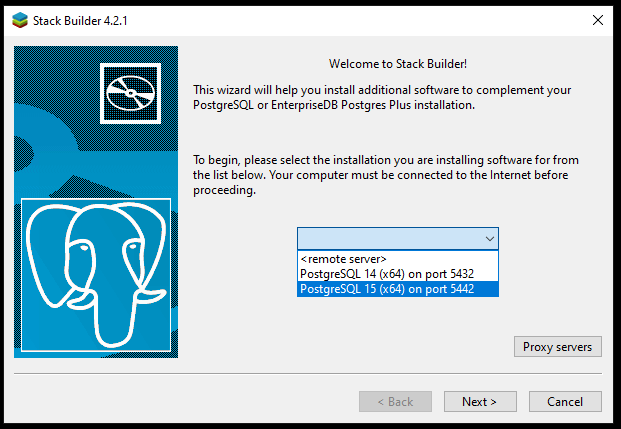 and pick the version of PostgreSQL you want to install PostGIS on and the version of PostGIS to install. and pick the version of PostgreSQL you want to install PostGIS on and the version of PostGIS to install.
You can upgrade from 2.+ to 3.+ without having to backup and restore your db. and ALTER EXTENSION postgis UPDATE; will do the trick after you've installed the latest PostGIS.
For versions of PostGIS from 2.5.3+ you can use SELECT postgis_extensions_upgrade(); to upgrade postgis, postgis_raster, postgis_topology, postgis_sfcgal, and postgis_tiger_geocoder.
There is a postgis sampler option) which creates a regular spatial db with all the extensions installed. The dumper,loader commandline and GUI tools in PostgreSQL bin folder will get overwritten by the last PostGIS you installed so be careful. Generally speaking PostGIS 3.1 should work just fine everywhere you were using PostGIS before. If you were upgrading from PostGIS < 2.2 you may need to install the legacy_minimal.sql or legacy.sql scripts packaged in PostgreSQL//contrib/postgis-3.1
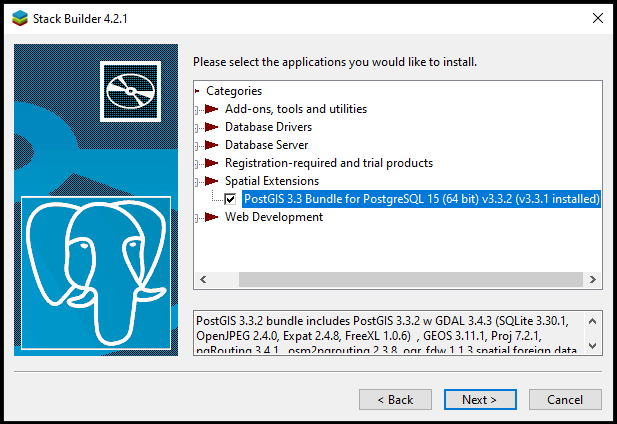 Navigate to spatial extensions and pick PostGIS 3.3. Download , install.
Please note the PostGIS windows installer, no longer creates a template database. Using Navigate to spatial extensions and pick PostGIS 3.3. Download , install.
Please note the PostGIS windows installer, no longer creates a template database. Using CREATE EXTENSION postgis; for enabling PostGIS in a database is the recommended way.
The create spatial database checkbox is optional, and we generally uncheck it. It creates a spatial database for you to experiment with and has all the extensions packaged with PostGIS Bundle pre-installed. 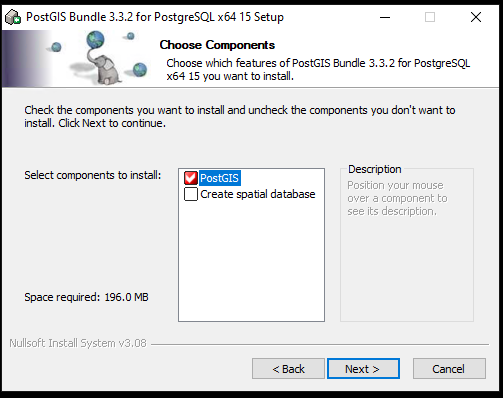
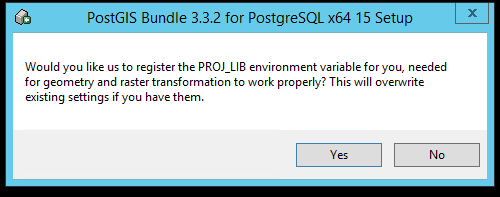 Do you want to register the PROJ dir. This is needed for geometry and raster ST_Transform Do you want to register the PROJ dir. This is needed for geometry and raster ST_Transform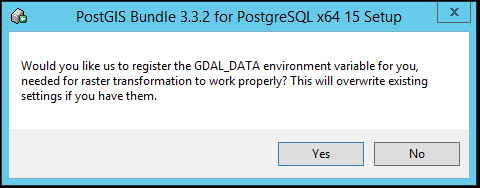 Do you want to register the GDAL_DATA prompt is needed for PostGIS raster and ogr_fdw extensions. This is because in order to do operations that require raster transformations or other rater warping / clipping etc, PostGIS uses GDAL epsg files. ogr_fdw uses configuration files for some vector types and these are stored in GDAL_DATA folder. The windows build, makes a local copy of these in the PostgreSQL install\gdal-data folder and saying yes will
automatically add/change an GDAL_DATA environment variable putting this path in for you. If you use GDAL already (or you are running both PostGIS 32-bit and 64-bit, chances are you already have this environment variable set and you may not want to overwrite it. PostGIS will work happily with an existing one, but just remember if you uninstall a PostGIS or your GDAL, these functions may stop working and you'll need to repoint the environment variable. Do you want to register the GDAL_DATA prompt is needed for PostGIS raster and ogr_fdw extensions. This is because in order to do operations that require raster transformations or other rater warping / clipping etc, PostGIS uses GDAL epsg files. ogr_fdw uses configuration files for some vector types and these are stored in GDAL_DATA folder. The windows build, makes a local copy of these in the PostgreSQL install\gdal-data folder and saying yes will
automatically add/change an GDAL_DATA environment variable putting this path in for you. If you use GDAL already (or you are running both PostGIS 32-bit and 64-bit, chances are you already have this environment variable set and you may not want to overwrite it. PostGIS will work happily with an existing one, but just remember if you uninstall a PostGIS or your GDAL, these functions may stop working and you'll need to repoint the environment variable.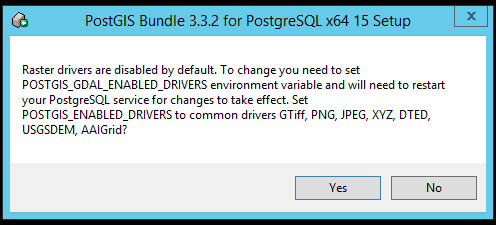 -- Enable Raster drivers. All raster drivers are disabled by default. Saying yes to this prompt allows the most common drivers (that are considered safe). E.g. they don't call out to web services etc. If you are not content with the list shown there, you may want to explicitly enable additional drivers using the GUC raster features PostGIS GDAL Enabled Raster Drivers GUC, that can either be set using -- Enable Raster drivers. All raster drivers are disabled by default. Saying yes to this prompt allows the most common drivers (that are considered safe). E.g. they don't call out to web services etc. If you are not content with the list shown there, you may want to explicitly enable additional drivers using the GUC raster features PostGIS GDAL Enabled Raster Drivers GUC, that can either be set using ALTER SYSTEM (for 9.4+), or ALTER DATABASE for specific databases.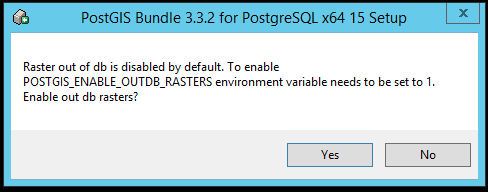 -- Out of database rasters are disabled by default for security reasons. If you need them, say yes to this prompt. Again if you want each database to have different settings, you can opt for the GUC route. Enable Out of Database rasters GUC -- Out of database rasters are disabled by default for security reasons. If you need them, say yes to this prompt. Again if you want each database to have different settings, you can opt for the GUC route. Enable Out of Database rasters GUCFor those of you who want to try experimental builds -- e.g. We have experimental Windows builds made as part of our continuous integration process when anything changes in the PostGIS code base. These can be downloaded from http://postgis.net/windows_downloads.
Creating a spatial database using SQL
You can use something like psql or the pgAdmin query window to create a database and spatially enable your database. This is the way to go if you have only a terminal interface to your db or you have a butt load of extensions you want to enable. Your psql steps would look something like this:
To install a bunch of extensions, just open up the pgAdmin SQL Query window (which we'll cover shortly) or psql and run this including only the extensions you want.
CREATE DATABASE gisdb;
\connect gisdb;
-- Enable PostGIS (includes raster)
CREATE EXTENSION postgis;
-- Enable Topology
CREATE EXTENSION postgis_topology;
-- Enable PostGIS Advanced 3D
-- and other geoprocessing algorithms
CREATE EXTENSION postgis_sfcgal;
-- fuzzy matching needed for Tiger
CREATE EXTENSION fuzzystrmatch;
-- rule based standardizer
CREATE EXTENSION address_standardizer;
-- example rule data set
CREATE EXTENSION address_standardizer_data_us;
-- Enable US Tiger Geocoder
CREATE EXTENSION postgis_tiger_geocoder;
-- routing functionality
CREATE EXTENSION pgrouting;
-- spatial foreign data wrappers
CREATE EXTENSION ogr_fdw;
-- LIDAR support
CREATE EXTENSION pointcloud;
-- LIDAR Point cloud patches to geometry type cases
CREATE EXTENSION pointcloud_postgis;
--- Uber h3 hexagon indexing scheme for PostGIS 3.3.2+ bundles
CREATE EXTENSION h3;
--- converts between h3 index representations
-- and postgis geometry/geography
CREATE EXTENSION h3_postgis;
Creating a spatial database using pgAdmin GUI
PostgreSQL comes packaged with a fairly decent admin
tool called PgAdmin3. If you are a newbie or not sure what extensions you want, it's best just to use that
tool to create a new database and look at the menu of extensions you have available to you.
On windows PgAdmin is under
Start->Programs->PostgreSQL 14->PgAdmin 4
You can also run pgAdmin not on the server and also just install it separately downloading from https://pgadmin.org, - Login with the super user usually postgres and the
password you chose during install. If you forgot it, then go into
pg_hba.conf (which is located where you specified data cluster in PostgreSQL install) (just open it with an editor such as notepad or a
programmer editor). Set the line
host all all 127.0.0.1/32 md5
to
host all all 127.0.0.1/32 trust
If you are on a newer windows (say 2008 or Windows 7), you may see an additional option
host all all ::1/128 trust
The ::1/128 is usually the controlling one and is what localhost resolves to in IPV6 so you'll want to set this one.
This will allow any person logging locally to the computer that
PostgreSQL is installed on to access all databases without a password.
(127.0.0.1/32) means localhost only (32 is the bit mask). Note you can
add additional lines to this file or remove lines to allow or block
certain ip ranges. The lines highest in the file take precedence.
So for example if you wanted to allow all users logging in access as long as they successfully authenticate with an md5 password, then you can add the line host all all 0.0.0.0/0 md5
. If it is below, you will still be able to connect locally without a password but non-local connections will need a valid username and password.
Note: - PgAdmin allows editing Postgresql.conf and pg_hba.conf using the PgAdmin tool. These are accessible from Tools->Server Configuration and provide a fairly nice table editor to work with. This feature is only available if you have installed the adminpack.sql (this is located in C:\Program Files\PostgreSQL\9.x\share\contrib) (Admin Pack) in the postgres database .
To install it --- switch to postgres database
and run this command in the sql window of PgAdmin or using psql:
CREATE EXTENSION adminpack;
(NOTE: you can also use the extensions gui of PgAdmin to install in the postgres db)
- Now for the fun part - Create your database. Call
it gisdb or whatever you want.
- It's generally a good idea to create a user too that
owns the database that way you don't need to use your superuser account
to access it.
Verify you have the newest PostGIS with this query:
SELECT postgis_full_version();
Should output something of the form
POSTGIS="3.3.2 3.3.2" [EXTENSION] PGSQL="150"
GEOS="3.11.1-CAPI-1.17.1"
SFCGAL="SFCGAL 1.4.1, CGAL 5.3, BOOST 1.78.0"
PROJ="7.2.1" GDAL="GDAL 3.4.3, released 2022/04/22" LIBXML="2.9.9"
LIBJSON="0.12" LIBPROTOBUF="1.2.1" WAGYU="0.5.0 (Internal)" TOPOLOGY RASTER
Loading GIS Data Into the Database
Now we have a nice fully functional GIS database with
no spatial data. So to do some neat stuff, we need to get some data to
play with.
Get the Data
Download data from the MassGIS site.
For this simple exercise just download Towns
Extract the files into some folder. We will only be using the _POLY
files for this exercise.
NOTE: Someone asked how you extract the file if you are on a linux box.
---FOR LINUX USERS ---
If you are on Linux/Unix, I find the exercise even easier.
If you are on linux or have Wget handy - you can do the below to download the file after you have cded into the folder you want to put it in.
wget http://wsgw.mass.gov/data/gispub/shape/state/boundaries.zip
Now to extract it simply do the following from a shell prompt
unzip boundaries.zip
---END FOR LINUX USERS ---
Figure out SRID of the data
You will notice one of the files it extracts is called
BOUNDARY_POLY.prj. A .prj is often included with ESRI shape files and
tells you the projection of the data. We'll need to match this
descriptive projection to an SRID (the id field of a spatial ref record
in the spatial_ref_sys table) if we ever want to reproject our data.
- Open up the .prj file in a text editor. You'll see
something like NAD_1983_StatePlane_Massachusetts_Mainland_FIPS_2001
and UNIT["Meter",1.0]
- Open up your PgAdmin III query tool and type in the
following statement
select srid, srtext, proj4text from
spatial_ref_sys where srtext ILIKE '%Massachusetts%' And
then click the green arrow. This will bring up about 10 records.
- Note the srid of the closest match. In this case
its 26986. NOTE: srid is not just a PostGIS term.
It is an OGC standard so you will see SRID mentioned a lot in other
spatial databases, gis webservices and applications. Most of the common
spatial reference systems have globally defined numbers. So 26986
always maps to NAD83_StatePlane_Massachusetts_Mainland_FIPS_2001
Meters. Most if not all MassGIS data is in this particular projection.
Loading the Data
The easiest data to load into PostGIS is ESRI shape
data since PostGIS comes packaged with a nice command line tool called
shp2pgsql which converts ESRI shape files into PostGIS specific SQL
statements that can then be loaded into a PostGIS database.
This file is located in the PostgreSQL bin folder
which default location in Windows is Program
Files/PostGreSQL/15/bin
Make a PostGIS mini toolkit
Since these files are so embedded, it is a bit
annoying to navigate to. To create yourself a self-contained toolkit
you can carry with you anywhere, copy the following files from the bin
folder into say c:\pgutils:
comerr32.dll krb5_32.dll libeay32.dll
libiconv-2.dll libintl-2.dll libpq.dll pgsql2shp.exe psql.exe
pg_dump.exe pg_restore.exe shp2pgsql.exe ssleay32.dll libproj-9.dll geos_c.dll geos
Note: The GUI loader is packaged as a self-contained postgisgui folder in the bin of your PostgreSQL install. If you prefer the GUI interface, you can copy that folder and run the shp2pgsql-gui.exe file from anywhere even an external file network path.
Load Towns data
- Open up a command prompt.
- Cd to the folder you extracted the towns data
- Run the following command:
c:\pgutils\shp2pgsql -s 26986 BOUNDARY_POLY towns > towns.sql
- Load into the database with this command:
psql -d gisdb -h localhost -U postgres -f towns.sql
If you are on another machine different from the server, you will need
to change localhost to the name of the server. Also you may get
prompted for a password. For the above I used the default superuser
postgres account, but its best to use a non-super user account.
- Alternatively you can use the gui to load the data and when you do, your screen will look something like this.
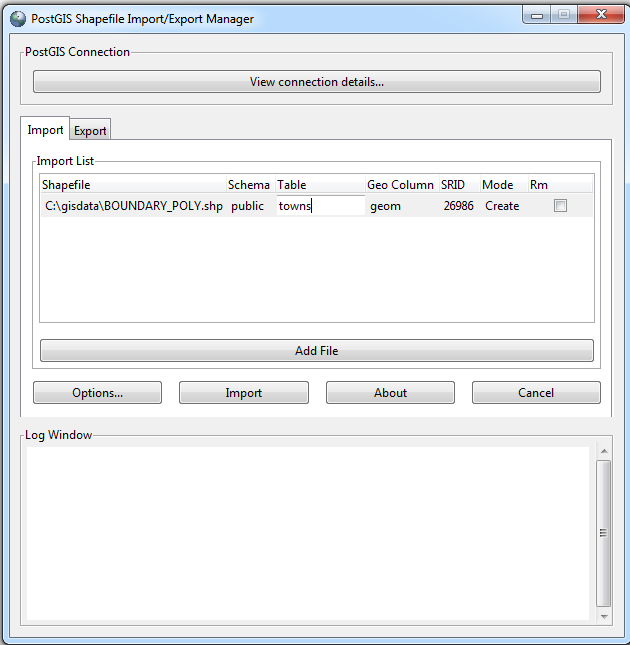 Which is a little different from the PostGIS 1.5 loader, because it allows uploading multiple files at ones. To edit any of the
settings for each file, click into the cell and the cell will become editable. In this case we replaced the default table name boundary_poly with towns. Which is a little different from the PostGIS 1.5 loader, because it allows uploading multiple files at ones. To edit any of the
settings for each file, click into the cell and the cell will become editable. In this case we replaced the default table name boundary_poly with towns.

- This particular dataset is only polygons. You can override the behavior of bringing in as multipolgons by clicking the Options button checking the Generate simple geometries ...
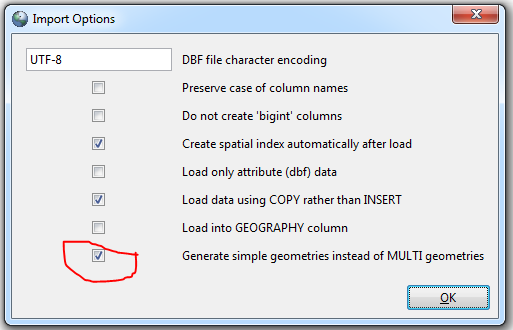 . .
One thing you can do with the shp2pgsql command line version pacakged with PostGIS 2.0-2.2, that you can't do with the GUI is to do a spatial transformation from one coordiante system to another. So witht eh command line, we can transform to 4326 (WGS 84) and load to geography type with a single command. Hopefully we'll see this in the GUI in a future release.
Indexing the data
Table indexes are very important for speeding up the
processing of most queries. There is also a downside to indexes and
they are the following
- Indexes slow down the updating of indexed fields.
- Indexes take up space. You can think of an index as
another table with bookmarks to the first similar to an index to a book.
Given the above, it is often times tricky to have a
good balance. There are a couple general rules of thumb to go
by that will help you a long way.
- Never put indexes on fields that you will not use
as part of a where condition or join condition.
- Be cautious when putting index fields on heavily
updated fields. For example if you have a field that is
frequently updated and is frequently used for updating, you'll need to
do benchmark tests to make sure the index does not cause more damage in
update situations than it does for select query situations.
In general if the number of records you are updating at any
one time for a particular field is small, its safe to put in an index.
- Corrollary to 2. For bulk uploads of a
table - e.g. if you are loading a table from a shape, its best to put
the indexes in place after the data load because if an index
is in place, the system will be creating indexes as its loading which
could slow things down considerably.
- If you know a certain field is unique in a table, it
is best to use a unique or primary index. The reason for this is
that it tells the planner that once its found a match, there is no need
to look for another. It also prevents someone from accidentally
inserting a duplicate record as it will throw an error.
- For spatial indexes - use a gist index. A gist basically
stores the bounding box of the geometry as the index. For large complex
geometries unfortunately, this is not too terribly useful.
The most common queries we will be doing on this query
are spatial queries and queries by the town field. So we will create 2
indexes on these fields. NOTE: The loader has an option to create the spatial index which we took
advantage of, so the spatial index one is not necessary but we present it here, just so if you ever need to create a spatial index, like for csv loaded data, you know how to.
CREATE INDEX idx_towns_geom
ON towns
USING gist(geom);
CREATE INDEX idx_towns_town
ON towns
USING btree(town);
Querying Data
Go back into PgAdmin III and refresh your view. Verify
that you have a towns database now.
Test out the following queries from the query tool
SELECT ST_Extent(geom) FROM towns WHERE town = 'BOSTON';
SELECT ST_Area(ST_Union(geom)) FROM towns WHERE town = 'BOSTON';
Viewing the Data
If you are a GIS newbie, I highly recommend using QGIS. QGIS has ability to view PostGIS data both geometry and raster directly, do simple filters on it, is free, is cross-platform (Linux, Windows, MacOSX,Unix) and is the least threatening of all the GIS Viewers I have seen out there for people new to GIS.
Post Comments About Part 1: Getting Started With PostGIS: An almost Idiot's Guide
|




